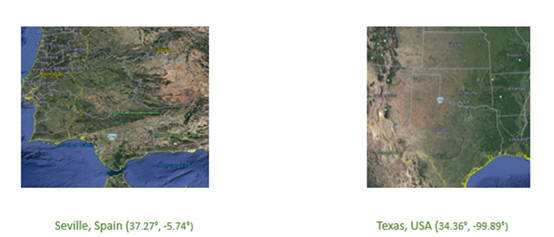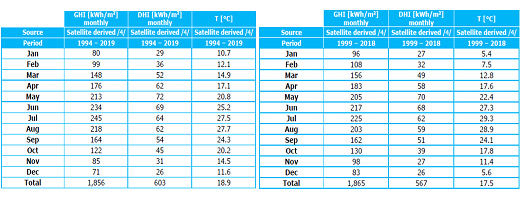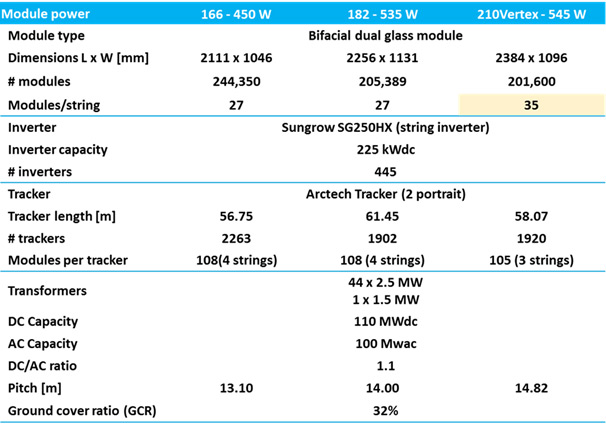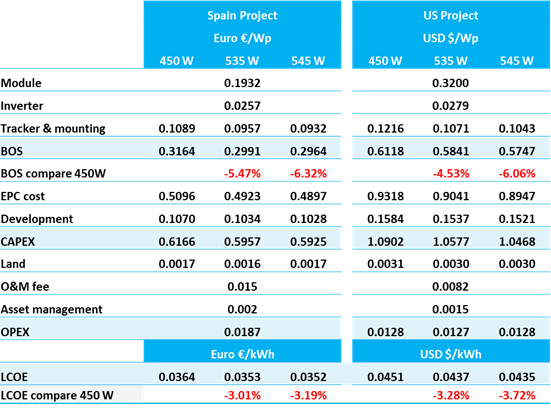DNV GL, the international leading design institutes and the well-known third-party organization, just reported the value of Trina Solar’s 600W+ Vertex Bifacial Dual-Glass Module with Single-Axis 2 portrait installation (2P) tracker, calculating their systematic advantages of BOS and LCOE, resulting the continuous BOS saving up to 6.32% and LCOE reduction by 3.72% compared with the 166mm bifacial dual-glass module. The assessment was carried out at two PV sites in Spain and the US, given their geographical representation.
This is DNV GL’s second run Assessment on Trina Solar’s 210 Vertex modules following the first round in early December 2020.
Steady Value Improvement on 210 Vertex Modules with Tracker
As the PV industry accelerates its entry into the era of grid parity, the Vertex series have a prominent strength in LCOE thanks to the continued efforts to cost reduction and efficiency improvement by Trina Solar. The assessment performed in last December found that Trina Solar’s 545W bifacial dual-glass Vertex module with single-axis 1 portrait installation (1P) tracker has the best LCOE, a drop of 3.5% compared with conventional 166mm-450W and 182mm-535W modules in terms of BOS costs.
DNV GL’s Technical Report (II) confirms the value of Trina’s Vertex modules according to the assessment results of Vertex module with single-axis 2 portrait installation (2P) tracker. Vertex’s innovative “low voltage, high string power” design boosts the single string power while lowering the initial investment and the cost at each stage.
Assessment Results: reducing BOS up to 6.32% and LCOE by 3.72%
The assessment of Vertex module with single-axis 2 portrait installation (2P) tracker took place in typical PV application sites in Spain and Texas, US, with the coordinates and climate as follows:

Coordinates of the projects

Monthly GHI&DHI data
In the above locations, DNV GL compared the BOS costs and LCOE of the bifacial dual-glass 166mm-450W module and 182mm-535W module with the Vertex bifacial dual-glass 210mm-545W module with single-axis 2 portrait installation (2P) tracker, based on fixed 100MW AC capacity, with the same DC/AC ratio design at the power station. In terms of system design, the projects adopted a single-axis 2 portrait installation (2P) tracker, equipped with a string inverter. The ground cover ratio (GCR) is fixed to ensure the consistent shading on the bifacial module.
Such design aims to maintain control over the influence of external factors and system configuration on the same site, to objectively compare costs and LCOE based on different modules. The comparison of the costs of the three tested groups are all based on local equipment, construction and installation, labor costs, grid interconnection fees, costs of operation and maintenance, land cost, and financial cost, so that the calculation is consistent, complete and objective.
The site system is configured as follows:
Site system configuration
Assessment results:

Assessment results in the Spanish project:
While compared to the 166mm-bifacial dual-glass-450W module, Trina Solar’s 210 Vertex bifacial dual-glass-545W can save the BOS up to 6.32%, reducing LCOE by about 3.19%. Compared to the 182mm-bifacial dual-glass-535W module, the BOS is down by 1%, with better performance in terms of LCOE.
Assessment results in the US project:
While compared to the 166mm bifacial dual-glass-450W module, Trina Solar’s 210 Vertex bifacial dual-glass-545W can save the BOS up to 6.06%, reducing the LCOE by about 3.72%. Compared to the 182mm-bifacial dual-glass-535W module, the BOS is down by 1.2%, reducing LCOE by about 0.5%.

Comparison of estimate costs
DNV GL reports: Higher Systematic Value, lowest LCOE with Trina Solar’s Products
After the Assessment on Vertex module with single-axis 1 portrait installation (1P) tracker, DNV GL confirms Trina’s value again according to the assessment results of Vertex module with single-axis 2 portrait installation (2P) tracker. First of all, Vertex’s innovative “low voltage, high strings power” design can interconnect more modules with the 1,500V voltage, which can boost the single string power. Secondly, the ultra-high power can reduce the numbers of modules in the setup. In turn, it can save the material and labor costs of DC cable work, and thus lowering the initial investment by reducing transportation, manual installation and civil work costs. Last but not least, with superior power generation performance, Vertex are able to maximize value for customers by ensuring a minimum LCOE.
Since establishment from 1997, Trina Solar has been driven by innovative, reliable quality and customer values. Since the release of the first advanced 210 Vertex modules in February 2020, the product line has been enriched with different products including Vertex S 400W, and the Vertex series of 500W, 550W and 600W and beyond, which fit well with the applications of residential, commercial and large scale power plant, as well as multiple scenarios of agriculture and fisheries. As planned by Trina Solar, the capacity of PV modules will be no less than 50GW by the end of 2021, and it will continue to strengthen the capacity of advanced modules with large-size cells in the future.
* For more information about DNV GL’s Technical Report on Trina Vertex BOS & LCOE, please contact Trina’s local sales representatives by sending the mail to VertexValue@Trinasolar.com
And please follow up “The Way to Best LCOE” series in the future.
